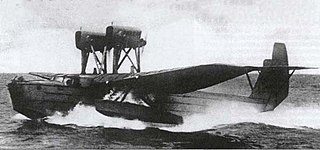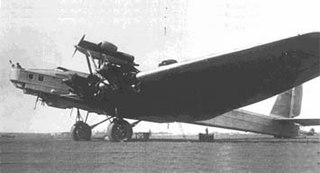Related Research Articles
Pre-revolutionary Imperial Russia did not have a single national unified system but instead relied on those provided by the manufacturers of the aircraft, like Sikorsky Ilya Muromets or Anatra Anasal.

Heavy bombers are bomber aircraft capable of delivering the largest payload of air-to-ground weaponry and longest range of their era. Archetypal heavy bombers have therefore usually been among the largest and most powerful military aircraft at any point in time. In the second half of the 20th century, heavy bombers were largely superseded by strategic bombers, which were often smaller in size, but had much longer ranges and were capable of delivering nuclear bombs.

The Sukhoi Su-2 was a Soviet reconnaissance and light bomber aircraft used in the early stages of World War II. It was the first airplane designed by Pavel Sukhoi. The basic design received an engine and armament upgrade (Su-4) and was modified for the ground-attack role (ShB).

The Tupolev ANT-7, known by the VVS as the Tupolev R-6, was a reconnaissance aircraft and escort fighter of the Soviet Union. The R-6 traces its roots back to early 1928 when the Soviet Air Force needed a long-range multirole aircraft. The requirements were that it could be used for long-range transport, defensive patrolling, reconnaissance, light bombing and torpedo attack.

The Tupolev TB-1 was a Soviet bomber aircraft, an angular monoplane that served as the backbone of the Soviet bomber force for many years, and was the first large all-metal aircraft built in the Soviet Union.

The Tupolev TB-3 was a monoplane heavy bomber deployed by the Soviet Air Force in the 1930s and used during the early years of World War II. It was the world's first cantilever wing four-engine heavy bomber. Despite obsolescence and being officially withdrawn from service in 1939, the TB-3 performed bomber and transport duties throughout much of World War II. The TB-3 also saw combat as a Zveno project fighter mothership and as a light tank transport.

The Tupolev Tu-2 was a twin-engine Soviet high-speed daylight and frontline bomber aircraft of World War II vintage. The Tu-2 was tailored to meet a requirement for a high-speed bomber or dive-bomber, with a large internal bombload, and speed similar to that of a single-seat fighter. Designed to challenge the German Junkers Ju 88, the Tu-2 proved comparable, and was produced in torpedo, interceptor, and reconnaissance versions. The Tu-2 was one of the outstanding combat aircraft of World War II and it played a key role in the Red Army's final offensives.

The Tupolev ANT-40, also known by its service name Tupolev SB and development co-name TsAGI-40, was a high speed twin-engined three-seat monoplane bomber, first flown in 1934. The Tupolev design was advanced but lacked refinement, much to the dismay of crews, maintenance personnel, and Stalin, who pointed out that "there are no trivialities in aviation".

Aerosani [singular = plural] is a type of propeller-driven snowmobile, running on skis, used for communications, mail deliveries, medical aid, emergency recovery and border patrolling in northern Russia, as well as for recreation. Aerosani were used by the Soviet Red Army during the Winter War and World War II.

The Tupolev ANT-14 Pravda was a Soviet aircraft, which served as the flagship of the Soviet propaganda squadron. It has been credited as Russia's first all-metal aircraft, with a corrosion-resistant-steel structure.

The ANT-8 was an experimental flying boat designed by Tupolev. It was designated the "MDR-2" by the military.

The Tupolev MTB-2, also known as the ANT-44, was a Soviet four-engine flying boat built in the late 1930s. Two prototypes were built; performance was satisfactory, but the design was overtaken by the fielding of long-range, land-based bombers by Soviet Naval Aviation and cancelled in 1940.

The Tupolev ANT-16 was an experimental heavy bomber aircraft designed and tested in the Soviet Union in the early 1930s.
Tupolev TB-6 was a proposal by the Tupolev Design Bureau in the 1930s for a super-heavy bomber. Had it been built, it would have been the biggest-ever Soviet bomber and the largest aircraft by wingspan of its time, nine feet short of the 320 foot span of the Hughes H-4 Hercules, although the Scaled Composites Stratolaunch is now the biggest plane by wingspan.
The Tupolev DB-1 (ANT-36) was a Soviet long-range bomber developed in the 1930s. It was developed from the Tupolev ANT-25 distance record-breaking aircraft. Development was prolonged and it was recognized as obsolete by the time it was in production. Only eighteen were built and all were withdrawn from service in 1937.

The Tupolev Tu-1 was a prototype Soviet night fighter variant of the Tupolev Tu-2 medium bomber that first flew after the end of World War II. It was cancelled when its experimental Mikulin AM-43V engines reached the end of their service life.
The Tupolev ANT-10 was a prototype single-engined light bomber/reconnaissance aircraft of the 1930s. Only a single example was built, the Polikarpov R-5 being preferred.
The Tupolev ANT-21 was a Soviet twin-engined four-seat heavy fighter, which also had the designation MI-3. It was not accepted for production, only two prototypes being built.
The Tupolev ANT-41 was a prototype Soviet twin-engined torpedo-bomber of the 1930s. A single prototype was built, which was destroyed in a crash. No production followed, with the Ilyushin DB-3 serving as a torpedo bomber instead.
The Tupolev ANT-30 was a mid-1930s project for a reconnaissance/strike 'cruiser-type' aircraft by the Tupolev Design Bureau.
References
- ↑ Kandalov, Paul Duffy ; Andrei (1996). Tupolev : the man and his aircraft. Warrendale, PA: SAE Internat. ISBN 1560918993.
- ↑ Gordon, Yefim; Komissarov, Sergey (2013). Unflown wings: Soviet and Russian unrealized aircraft projects 1925-2010. Birmingham: Ian Allan Publishing Ltd. ISBN 978-1906537340.